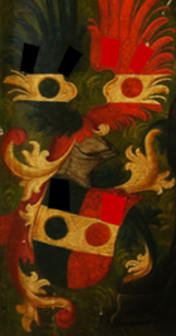
LOCHNER OF NUREMBERG
UPPER CLASS FAMILY WITH IMPERIAL FIEFDOM
~1400 – ~1600
In Nuremberg, the old free imperial city, where the electors until today are revolving around emperor
Charles IV in the chimes of the Frauenkirche („women’s church“) on Hauptmarkt („main market“), admired by thousands of tourists, and who – as well – generated the “Golden Bull” in 1356, which marked that election of the king of the Holy Roman Empire German Nation to be established for all time by the seven electors, another Lochner line will rise in the short term. They are an “honourable family” of the free imperial city, which in their case could have been seen as a kind of “precursor” to the city’s patrician class, because these elder families are not “afraid” to marry their daughters to the Nuremberg Lochners.
This line apparently descends from the Drossenfeld Lochner’s, they are closely related to the Lochners of Huttenbach and the Bohemian Lochners of Palitz, and move to Nuremberg in the late 14th century. They are referred to as an “upper class family with imperial fiefdom” – and of aristocratic origin (see above detail towards the coat-of-arms of LVN: donor picture of the Lochner-Pirckheimer family “Resurrection of Christ” – today hanging in the Museum for Franconia, Wurzburg – edited by Katharina Bruetting called Lochner). The first Lochner to be mentioned in the registers of Nuremberg (Standbuecher) at those times is in 1406: Eberhard Lochner (of Drossenfeld).
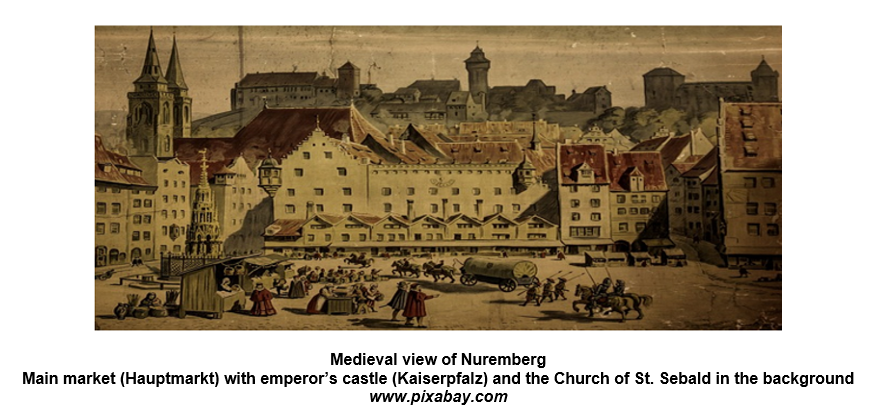
With John I Lochner, a pharmacist at Nuremberg’s Burgstrasse 1, and his wife Christina Holzberger, he has a son of the same name, John II Lochner. This Lochner line commissions two paintings that nowadays are hanging in museums in England and Wurzburg and are of huge art historical value, and so an authentic image of Lochners have been preserved from the Middle Ages. According to the art historian Anna Moraht, Berlin, „… the inventory of Franconian paintings from the middle of the 15th century is relatively manageable – for this reason alone, the Lochner-Pirckheimer donor painting from around 1465 is a real treasure!“[1]

„Resurrection of Christ“
-donors: physician John II Lochner of Nuremberg
and his wife Clara Pirckheimer-
Nuremberg, around 1467
145 x 215,5 cm
„Resurrection of Christ“ epitaph for the Lochner-Pirckheimer family, Nuremberg, around 1467
at the Museum for Franconia, Wurzburg,
with kind approval by Katharina Nittel – photography by Katja Krause, Wurzburg –
Possession of „Leihgabe der Freunde Mainfränkischer Kunst und Geschichte e.V. Wurzburg
at the Museum for Franconia in Wurzburg“, Inventory-No. A. 11452
John II Lochner is a respected physician, working both as personal doctor for the House of Hohenzollern and as the city doctor of Nuremberg. In 1435 he went on a long journey of seven months with the sons of the Margrave of Ansbach, John and Albrecht Achilles, to Jerusalem – afterwards writing a detailed, geographically and topographically important report[2]. These travel councils have survived to this day in London, as to have tips for avoiding the omnipresent plague (John II Lochner himself has survived several plague epidemics, such as in Nuremberg in 1437, 1474 and 1483) for his son John III Lochner of Nuremberg, who is a high-ranking clergyman in matters of the free imperial city of Nuremberg at the Vatican in Rome and advisor to Emperor Frederick III, as well as to Duke Sigismund of Tyrol and Margrave Albrecht of Brandenburg[3].
This is particularly underlined by the text of the letter Prof. Dr. Claudia Maertl (Ludwig Maximilian University of Munich) refers to in the introduction of her contribution to the Pirckheimer Yearbook 2003 for Renaissance and Humanism Research (Volume 18) about
“il doctorissimo”, like John III Lochner of Nuremberg is mentioned in Rome, thus on the topic about “Venetian-German cultural relations in the Renaissance”:
“In March 1464, a young man from Nuremberg named Sebastian Lochner came to the court in Mantua of Margravine Barbara Gonzaga, born Hohenzollern. He was on his way to Rome, where he wanted to pick up his brother John Lochner to accompany him back to Germany. To authenticate his identity, Sebastian showed the Margravine a letter from her mother from Bayreuth, in which she praised the father of the brothers in the highest tones: “If we didn’t have him often, we just died a long time ago, but survived with the blessing of God and his abilities”. In fact, the physician Dr. John Lochner – personal physician to the Hohenzollern and Nuremberg’s city doctor – was a widely renowned authority. Barbara Gonzaga adapted her mother’s formulations in her own Italian letter of recommendation, which was addressed to several high-ranking members of the Curia, and added that she felt an obligation to all members of the Lochner family, who had always shown great loyalty to the House of Hohenzollern”[4].
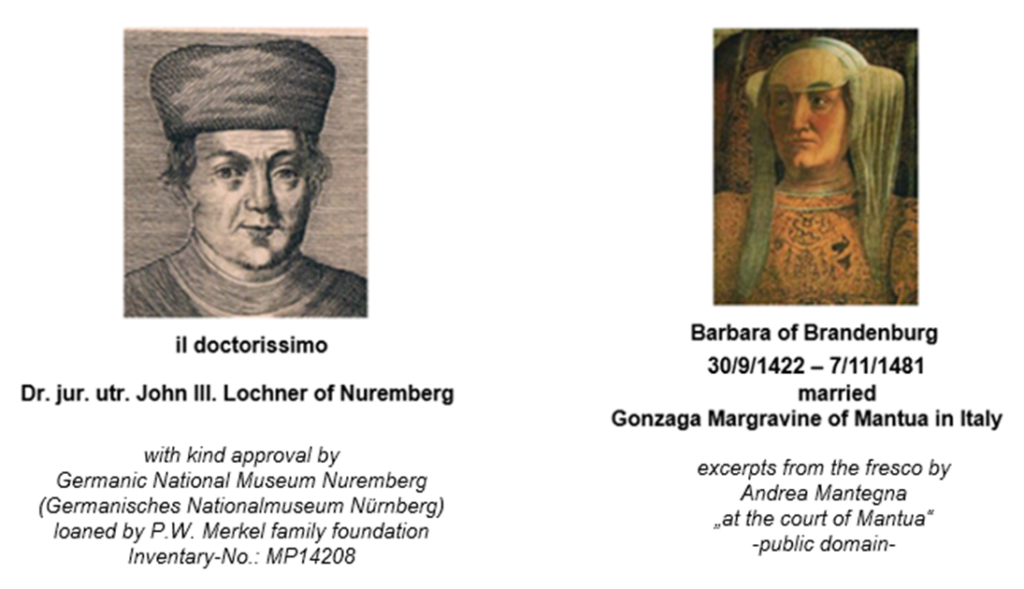
Barbara Gonzaga of Mantua[5], born Hohenzollern (so to say of “early Prussian origin”), maintains active correspondence with John III Lochner, from which it is clear that the two – although there is a huge difference in status – have a relationship that can be described as friendship – more or less [6].
The medical city doctor John II Lochner not only manages to marry into a famous Nurembergian family, but with Clara Pirckheimer, a “great-grandaunt” of Albrecht Durer’s friend Willibald Pirckheimer and advisor to Emperor Maximilian I, he fathers 16 children, of which just four reach adulthood. The high child mortality rate in the Middle Ages is the main reason why the final rise to the patrician class is impossible. This was certainly considered, as he had ordered his own coat-of-arms variant of the Lochner coat-of-arms created in 1431, in particular the originally silver crossbar is now “gilded” and covered with 2 balls (= or “holes” – Loch-ner in German language has that meaning), the helmet ornament forms an “open flight” instead of the usual buffalo horns[7].

His daughter Clara gives her husband Leonard Pregler four living children, but his surviving next son, Sebastian Lochner (mentioned above) and his wife Martha from the patrician family of the Futterer, who are proud owners of a copy of the Augsburg Bible, have no further offspring (twin sons die after a few months and a disabled son named Wolfgang lives in the Augustinian monastery in Neunkirchen a.B. from 1489 on)[8]. The same sad fate befalls the third son Michael II Lochner, according to Germanic National Museum (‘Germanisches Nationalmuseum’), Nuremberg – “Durer Internet Portal”: he is also in friendship with Albrecht Durer, who, with his wife Catherine of Ploben, has the son Michael III, who dies in young age and the daughter Catherine Lochner of Nuremberg.
Her father, Michael II Lochner of Nuremberg, is a rich merchant who is the first to import Venetian glass to Nuremberg and controls the trade route between the two cities. To his only daughter he made a special gift namely two extraordinarily beautiful glass cups for her wedding, which will impress Nuremberg’s patrician class so much that – as a result – this becomes fashionable among families such as the Imhoff.
Today one of these artistic beakers is to be seen in the Corning Museum of Glass in Corning, New York (the biggest glass museum of the world), and it shows the images of St Catherine and St Michael, as well as the coat-of-arms of the family Behaim of Schwarzbach. Their introduction testifies a new aesthetic sensibility among the urban elite of Northern Europe, Andrea Bayer says – Deputy Director for Collections and Administration at The Metropolitan Museum of Art[9].
Catherine Lochner of Nuremberg celebrates wedding with none other than Michael IV Behaim of Schwarzbach on July 7, 1495:
councilor, mayor and patrician of the free imperial city of Nuremberg. He is the younger brother of the inventor of the world’s first globe, Martin Behaim, which can now be viewed at Germanic National Museum (‘Germanisches Nationalmuseum’), Nuremberg (UNESCO World Heritage Site since 2023), and, as he is a world’s voyager for the Kings of Portugal, he often visits them when reaching his hometown.

„B e h a i m – B e a k e r“
wedding present of
Michael II Lochner of Nuremberg
for his only daughter Catherine Lochner of Nuremberg
and Michael IV Behaim of Schwarzbach on July 7, 1495
Excerpts from the painting „Christ taking leave of his mother“ (Compton Verney Art Gallery, Warwick, U.K.) –
donors – left side: Michael II Lochner of Nuremberg and on the right side: his daugther Catherine Lochner of Nuremberg,
married Behaim of Schwarzbach – edited by Katharina Brutting called Lochner
The Behaim Beaker (probably 1495). CMoG 84.3.24. Purchased with funds from the Museum Endowment Fund
Image licensed by The Corning Museum Of Glass, Corning, N.Y. (www.cmog.org), under CC BY-NC-SA 4.0 –
photographs of the Behaim-Beaker of 1495 – with kind approval by The Corning Museum Of Glass, Corning, New York State, U.S.A.
former owners:
collection Fritz and Mary Biemann until 1984
collection Robert von Hirsch until 1978
Michael and Catherine remain childless. However, since 1511 they have been raising their nephew, Michael V Behaim, the son of his brother Stephan and his wife Margret Ortolff. Stephan has died in 1511. The nephew becomes the foster son and heir to the „Behaim beakers“ and the painting by Catherine’s father, Michael II Lochner of Nuremberg, until his training starts in Milan in 1523. In addition, in 1511/1512 both of them worked as “foundling carers”, i.e. responsible for orphans in the city of Nuremberg. In 1527, Catharine, Martin Behaim’s sister-in-law, dies and leaves her heritage to the poor (close relatives of this Lochner line are related by marriage to other patrician families – see below)[10].
So, Michael and Catherine also commission a painting “Christ taking leave of his mother” (see below), which is attributed to Hans Leonard Schaeufelein from Albrecht Durer’s circle of 1506 and probably has hung in the church of St. Sebald in Nuremberg. It can now be seen at Compton Verney Art Gallery, in Warwick, U.K. (near Birmingham), and it shows the alliance crest of the Lochners of Nuremberg and their married families:

„Christ taking leave of his mother“
-donors: Michael II Lochner of Nuremberg
and his wife Catherine of Ploben,
Nuremberg, 1506-
149,5 x 119 cm
left side: Michael II Lochner of Nuremberg (whose coat-of-arms is facing his wife’s one,
that is why the colouring appears reversed – a heraldic polite gesture)
and his son Michael III Lochner
right side: the daughter Catherine Lochner of Nuremberg
with her alliance crest of the Lochner of Nuremberg
and Behaim of Schwarzbach, close to
her mother Catherine of Ploben, before her coat-of-arms of the Ploben-family
Painting at Compton Verney Art Gallery, Warwick, U.K. –
with kind approval by the Collections and Exhibitions Manager Annelise Hone,
Reference-No.: CVCSC:0268.N „Master of the Schwabach Altarpiece Christ Taking Leave Of His Mother 1506“ –
Compton Verney, photograph by Jamie Woodley
With Werner II Lochner of Nuremberg (~1420–1494), the clergy is again represented in the Nuremberg line of the old Frankish knightly family. From 1461 to 1494, he is the abbot of the Benedictine monastery of St John in Michelfeld (now a district of Auerbach in Upper Palatinate). He appears in several documents, which shows that he invests in fiefdoms where iron hammers are operating. Since the region of Upper Palatinate is considered the „iron processing industry“ such as the „German Ruhr Industrial Area“ today but in the Middle Ages before the Thirty Years‘ War (1618–1648), this is certainly an important source of income for the monastery.
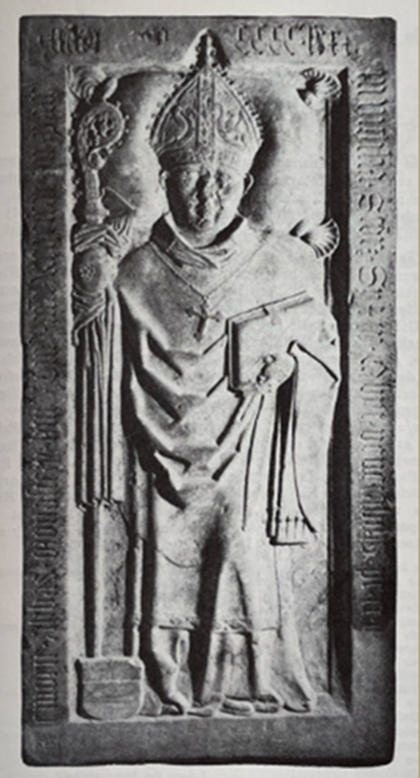
Werner II. Lochner of Nuremberg
Abbot of Michaelfeld monastery
1461 – 1494
Close relatives of this noble Lochner line are related to important patrician families and are active as physicians in the tradition of John II Lochner (as can be seen from an unpublished manuscript by Manfred Grieb – provided by Dr. Thomas Eser, Director of the Nuremberg City Museums):
This includes John IV Lochner of Nuremberg (1475 – 1525), who lives with his family at the Milchmarkt (today: Albrecht-Durer-Platz) in Nuremberg, at „Untere Schmiedgasse 3“. In 1509, he also appears as Nuremberg’s city physician and is married to the patrician daughter Kunigunde Holzschuher of Harrlach (1484 – 1550). She succeeds her relative, Catherine Lochner of Nuremberg (Behaim), who has died in 1527, and continues her role as caretaker of the foundling home, i.e., for orphaned children, on behalf of the imperial city of Nuremberg.
The Holzschuher of Harrlach are one of Nuremberg’s oldest patrician families, first mentioned in 1228 and still in existence today. The Holzschuher probably originate from the knighthood (vassalage) in the Nuremberg area. The Holzschuhers, who become wealthy through trading in Flemish cloth, are represented in the „Inner Council“ from 1319, with brief interruptions, until the end of the imperial city period in 1806. According to the „Dance Statute“ of the Nuremberg patriciate, they are among the twenty old families eligible for council membership. The Holzschuher trading house is one of the imperial city’s most important businesses in the late Middle Ages and early modern period.
The sons of the aforementioned Lochner physician, John V Lochner of Nuremberg (~1515 – 1533), who presumably takes over the house on the Milchmarkt in Nuremberg (“Untere Schmiedgasse 3”) as the eldest, marries Ursula Imhoff in 1533, shortly before his death. He evidently has been responsible for foundlings – together with his mother – since 1526. Due to his early death, his second brother, Jobst Lochner of Nuremberg (1519 – 1584), also a physician, will inherit the house at the Milchmarkt, where he lives with his wife, Helena Imhoff, who, like her sister-in-law, comes from a Nuremberg patrician family as well. As a physician, he held the important position of a caretaker of the so-called „Siechkobel“ (infirmary for lepers) at St Johannis in Nuremberg from 1563 – 1584. At the same time, from 1577 until his death in 1584, he is responsible as an alms officer in behalf of the city of Nuremberg
The sister of the two physicians, Kunigunde Lochner of Nuremberg (~1517 – 1571), is intended by her parents to marry another Nuremberg patrician, Christoph I Harsdorffer of Enderndorf (1505 – 1578). Their daughter, Susanna (1549 – 1621), later on will be the wife of John Oelhafen of Schollenbach.
The Harsdorf of Enderndorf family (historically also known as the Harsdorffer family) are patricians of Nuremberg, first documented in 1377. With brief interruptions, from 1450 until the end of the imperial city period in 1806, the Harsdorf family were members of the „Inner Council,“ meaning they belong to the ruling families. They originate from the knighthood around the town of Kulmbach near Bayreuth, probably from the village of Harsdorf of the same name. Around the middle of the 14th century, two knights of the Harsdorf family will settle in the imperial city of Nuremberg and accept citizenship in 1377/80. Upon admission to the „Inner Council“ in 1450, they are admitted to the Nuremberg patriciate. Their wealth primarily increases through long-distance trade. The Harsdorf family continues to operate as mining entrepreneurs in the copper mining districts of Thuringia and Saxony until the early 17th century, and in their later phases, they are closely associated with the Imhoff patricians. A branch is found in the imperial city of Ulm; in 1813 they are registered as „nobles“ in the Bavarian nobility, and in 1841 they are elevated to the Bavarian baronial rank.
The Imhoffs are one of the oldest and most important patrician families in Southern Germany and build one of the largest trading houses in Europe. Probably originally descend from a knightly family, they become part of the patriciate of the town of Lauingen on the Danube in the mid-13th century. Starting in 1268, a branch moves to Nuremberg, and around 1350, they are admitted to the Nuremberg patriciate. The Nuremberg Imhoffs are represented in the „Inner Council“ from 1402 to 1806 and, through the acquisition of estates, were simultaneously admitted to the imperial knighthood.
The Nuremberg-based „Imhoff Trading Company“ and other family businesses are active in trade between Venice, Nuremberg, and Eastern Europe around 1381. Branches of the family settle in other Upper German imperial cities and trading centers such as Augsburg (1396), Ulm (1422), Donauworth (around 1425), and Memmingen (1441). Early branches have existed in Venice, Salzburg, Linz, Prague, Brno, and Olomouc. They are among Europe’s leading entrepreneurs and make significant profits from the trade in Italian saffron. Around 1500, the Imhoffs expand their trading and bartering activities into money and banking, participating in silver and gold mining in Saxony and Silesia (today Poland). From 1540 onward, they finance European courts with loans.
Several branches of the family are based in Augsburg from 1395 until the 19th century; in 1538, they are admitted to the local patriciate. While the Nuremberg branches become Protestant during the Reformation, the Augsburg Imhoffs remain Catholic. Branches of the family will later spread to Austria, as well as Saxony, Brunswick, Hanover, and the Netherlands. Some of these lines survive to this day and are elevated to the rank of imperial barons in 1679, while the others are elevated to the rank of Bavarian barons in the 19th century.
According to current knowledge, this line of the Lochners of Nuremberg died out around 1600.-
E N C L O S U R E:

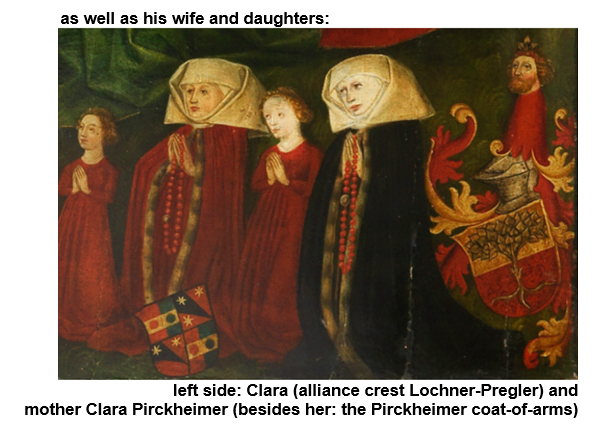
„Resurrection of Christ“ – Donors of this painting is the Lochner-Pirckheimer family, Nuremberg, about 1465 –
in the Museum for Franconia, Wuerzburg, with kind approval of Katharina Nittel, photo by Katja Krause, Wuerzburg –
loaned by “Freunde Mainfränkischer Kunst und Geschichte e.V. Wuerzburg at Museum for Franken, Wuerzburg,
inventory no. A.1145


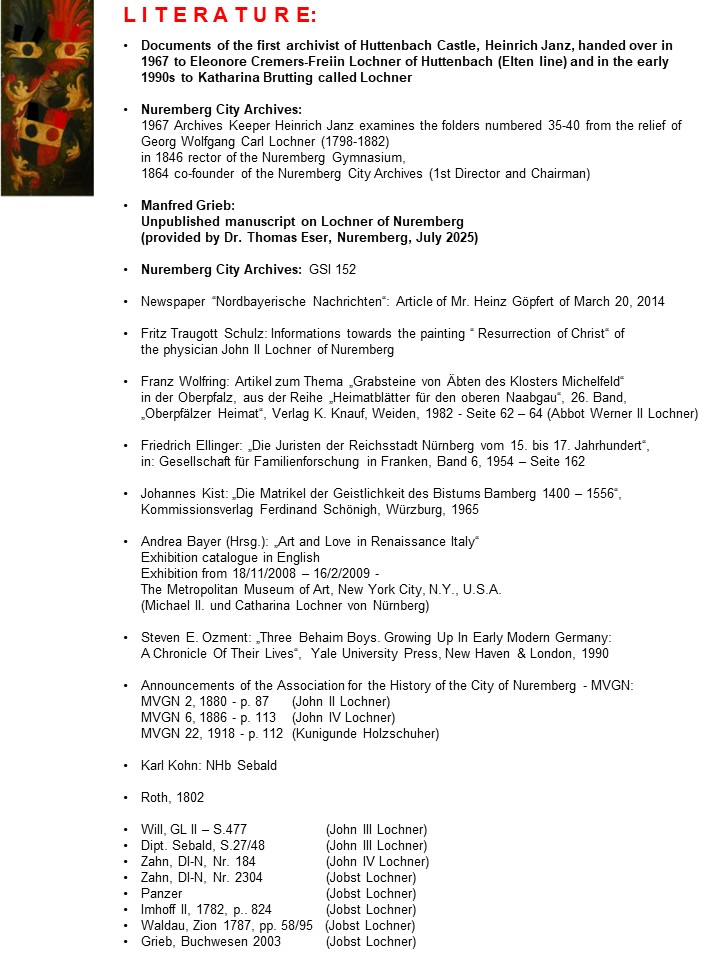
* * *
UNAUTHORIZED DISTRIBUTION PROHIBITED
Copyright: July 2025 – lochner-archiv@web.de
-
Citation according to the email of August 5, 2023 to the authoress ↑
-
Johann Kamann (Editor): „The pilgrimages of Nuremberg citizens to Jerusalem in the 15th century, especially the travel reports of Dr. med. John Lochner and Joerg Pfinzing“, in: MVGN 2 (1880), p. 78 – 163 ↑
-
Wellcome Historical Medical Library – Cod. Wellc. 433 – author: H. J. Vermeer: „John Lochner‘s travel consultations“
in: Sudhoffs Archives for the history of medicine and natural sciences 56 (1972), p. 145 – 196 ↑ -
The letter of Barbara of Brandenburg to her daughter of the same name Barbara Gonzaga is to be found at: Archivio di Stato Mantova, Archivio Gonzaga, Italy, b. 514 fol. 51r of 7th February 1464; the letter of recommendation of Barbara Gonzaga for Sebastian Lochner in ASMnAG b. 2887 l. 43 fol. 87v – 88v of March 14, 1464 ↑
-
Portrait of Barbara Gonzaga Margravine of Mantua in Italy (detail of the fresco by Andrea Mantegna), 15th century ↑
-
Wording of Prof. Dr. Claudia Maertl – from: “Pirckheimer Yearbook 2003 for Renaissance and Humanism Research (Volume 18) about “il doctorissimo”, like John III Lochner of Nuremberg is mentioned in Rome, thus on the topic about “Venetian-German cultural relations in the Renaissance” ↑
-
Coat-of-Arms of the Lochner of Nuremberg at the heraldic book by Siebmacher as „Lochner I – deceased Bavarian nobility II „, panel 77:
awarded by King Sigismund to medical doctor John II Lochner – Sabbato post Ulrici 1431, imperial noble files (Reichsadelsakten) of July 7, 1431, Regesta Imperii XI, No. 8681 – Austrian State Archives, Vienna: AT-OeStA/AVA Adel RAA 253.18 ↑ -
City library of Bamberg StA BA 113 Nr. 4, f. 64/65 and f. 67/68. His father Sebastian Lochner handed over singularly 300 fl in 1489 to the monastery as a socalled
„Leibgeding“ (= pension in old age). ↑
-
Andrea Bayer (Editor): “Art and Love in Renaissance Italy“, Metropolitan Museum of Art, New York, U.S.A. – details concerning these beakers were kindly provided to Mrs. Bayer by Mr. Dedo of Kerssenbrock-Krosigk of the Corning Museum of Glass in Corning, New York State, U.S.A. (today he is head of the German Glass museum Hentrich/Kunstpalast Duesseldorf) – as well as –
Anne Simon: „The Cult of Saint Catherine of Alexandria in Late-Medieval Nuremberg“ – Taylor & Francis Ltd, New Edition 2012 –The 2nd beaker is nowadays privately owned in Bremen. ↑
-
Descendant list of Lorenz Holzschuher of February 2nd, 2016: „Holzschuher – Muffel – Pfinzing“ (No. 986 Cunegunda Lochner, died in 1575, married to No. 1003, Christoph I Harsdoerffer, born 1505 – died in 1573) ↑